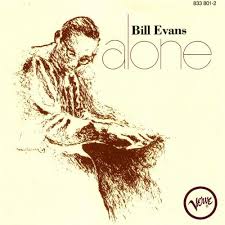For someone who practically represents mainstream jazz piano, Bill Evans is actually quite individualistic. When we hear local pianists play “generic” jazz piano, they’re usually firmly entrenched in his style, but when we hear the man himself play, what we’re really hearing is a highly personal distillation of his influences. Many musical streams of influence, in fact.
(If you’re new to jazz piano, welcome aboard! Here’s a famous recording of Evans doing his “thing.”)
But Evans didn’t start out by playing this way. He once recalled that as a teen he was known as “the fastest boogie woogie piano player in New Jersey.” (Can you even imagine Bill Evans playing boogie woogie???)
But in fact his early recordings show an uncompromising willingness to explore new directions in music, from minimalist approaches to the avant garde. Here’s “Peace Piece,” from his 1958 debut as a leader. Even though it has the musical “feel” we associate with Evans’ mature style, the piece is radical in that it consists of just 2 chords, repeating over and over. It sounds like a jazz version of Satie. Evans rarely used this approach again.
Have you heard this one? It’s Evans soloing on George Russell’s composition “All About Rosie.” He sounds like Lennie Tristano, another approach he soon left behind.
What Evans didn’t leave behind, though, were the musical principles he learned by exploring these styles. In “Peace Piece,” he used the simple chord progression to enable him to express the musical mood he wanted, without having to navigate through a complex harmonic route. Later, he could do the the same over jazz standards.
Perhaps prompted by George Russell’s composition, Evans’ playing in “All About Rosie” displayed a rigorous motivic approach to constructing solos. But it was still couched in the rhythmic and tonal style of Lennie Tristano. Most of Evans’ later playing can be seen as a combination of these two approaches: a rigorous motivic approach within the emotional mood and flow of “Peace Piece.”
Bill Evans had a brilliant analytical mind. He tried every musical style he could think of, and took what he wanted from each one, incorporating their various approaches into the unique and personal jazz piano sound we now associate with him. Perhaps this is the most important lesson we can learn from his journey.
How can you do the same regarding your own playing?
Take your left hand playing to a new level with my free ebook: Left Hand Techniques for Jazz Piano
You’ll also get my weekly jazz newsletter with practice tips and inspiration


And happy almost 86th Birthday to Mr E. Love Miss Ecks.
Wow! Total coincidence that I wrote this the day before his birthday. I’ll have to post a birthday tribute tomorrow (August 16th).
[…] I wrote one of my most-shared blog posts, about the jazz pianist Bill Evans, blissfully unaware that I was posting it just one day before […]